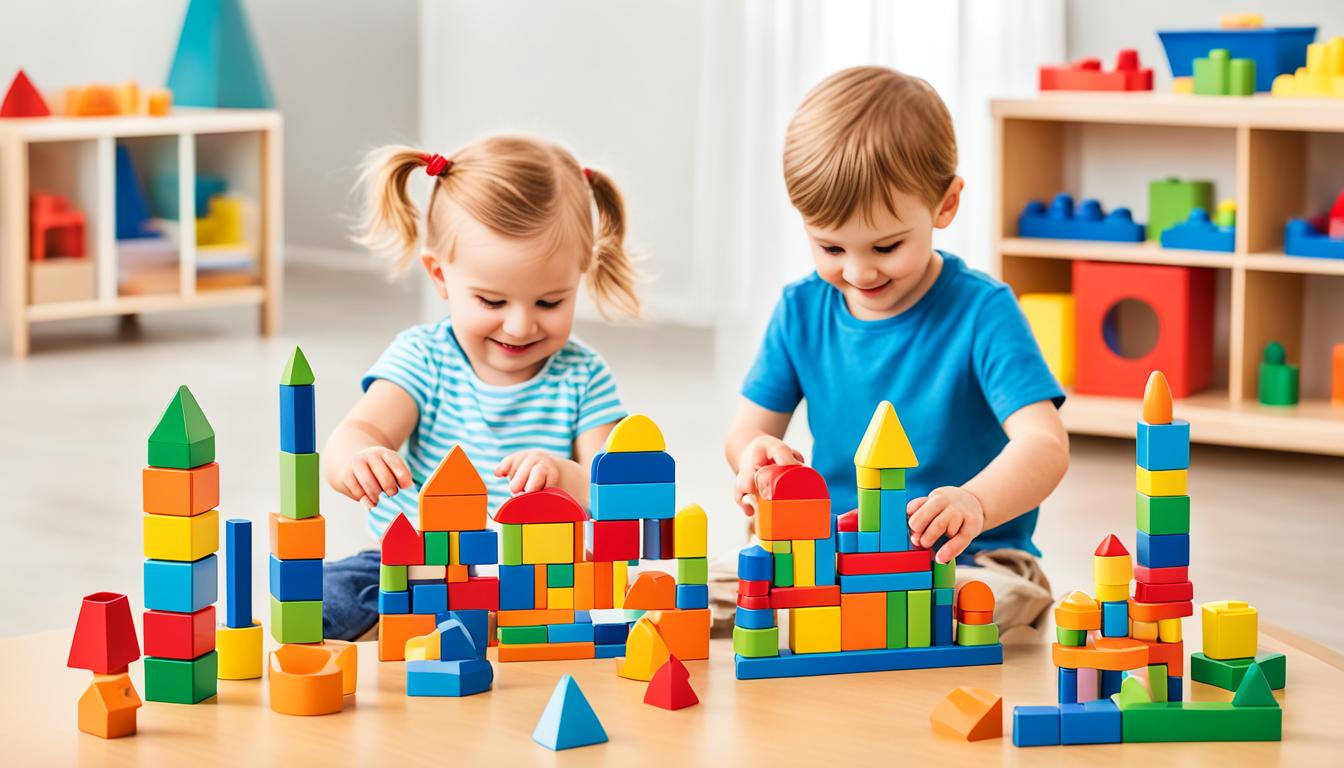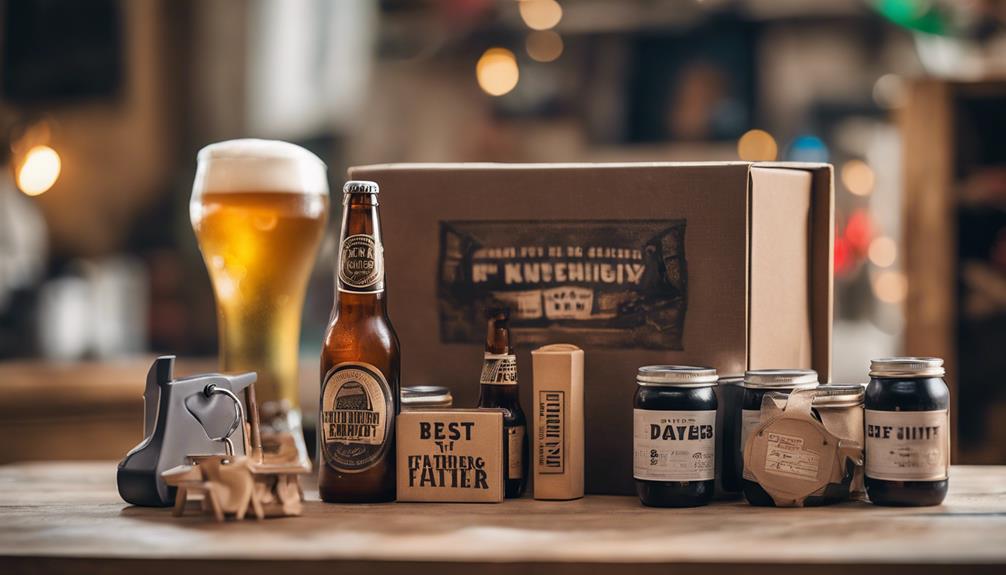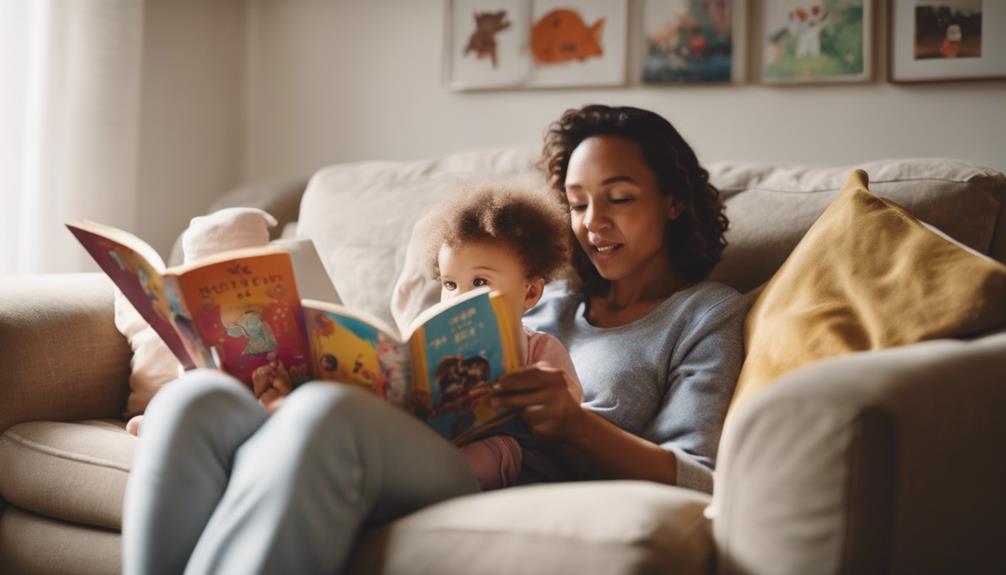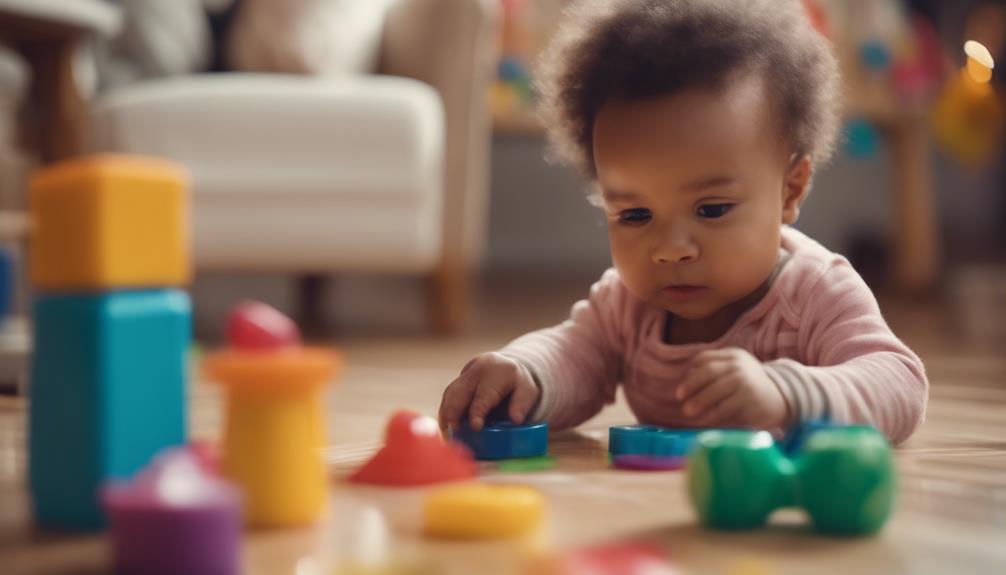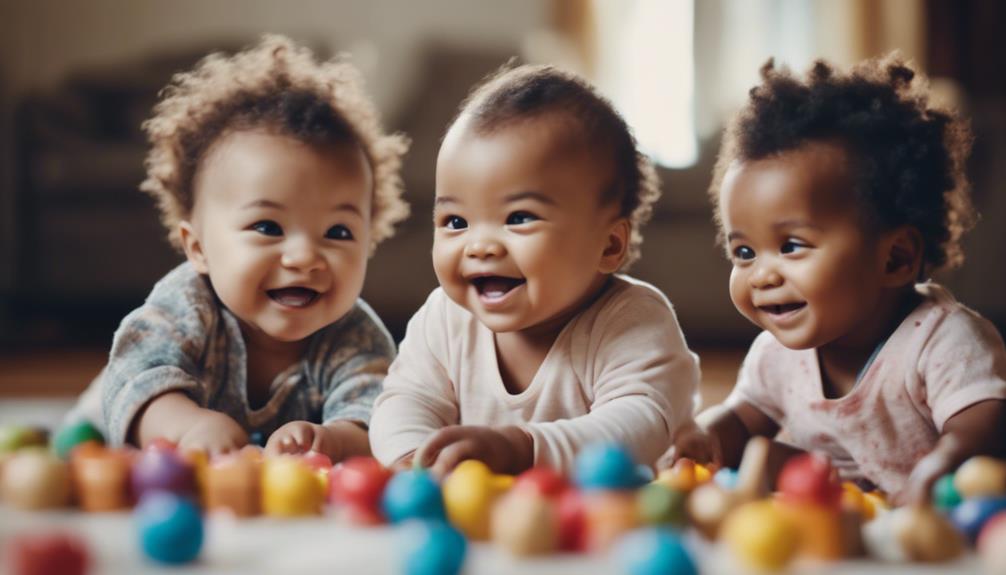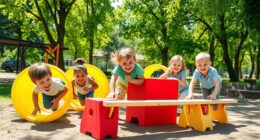Every child is born with a natural inclination towards learning, filled with curiosity and a desire to discover the world around them. As a parent, you have a crucial role in supporting their growth and development, and one effective way to do that is through the act of play.
Choosing the right educational toys for your toddler can enhance their cognitive development, fine motor skills, creativity, and social-emotional development. These toys create a fun and engaging learning experience that sets the foundation for a lifetime of curiosity and discovery.
Let’s take a look at some of the top educational toy picks that are sure to unlock your toddler’s inner genius:
Connetix Magnetic Tiles: Sparking Creativity and STEM Learning
Connetix Magnetic Tiles1 are a favorite among parents and educators alike. These colorful magnetic tiles allow children to build and create using their imagination. From simple structures to intricate designs, these tiles promote creativity, spatial awareness, and problem-solving skills. They also introduce basic principles of science, technology, engineering, and math (STEM), laying the foundation for future learning.
PlanToys Wooden Block Set: Eco-Friendly Construction for Fine Motor Skills
For eco-conscious parents, the PlanToys Wooden Block Set1 is an excellent choice. This construction set is made from sustainably sourced rubberwood, enhancing fine motor skills and hand-eye coordination. Toddlers can explore various shapes and sizes, learning about balance and stability as they stack and build. This eco-friendly toy promotes imaginative play and creativity while being kind to the planet.
Haba Marble Run: Gravity, Momentum, and Engineering Concepts
Marble runs have always been a hit with kids, and the Haba Marble Run1 takes the fun to a whole new level. This colorful marble run set introduces children to the concepts of gravity, momentum, and engineering. As they experiment with different configurations, they develop problem-solving skills and learn about cause and effect. It’s a toy that keeps children engaged while instilling a love for science and engineering.
Tender Leaf Toys Weather Watch Station: Exploring the Weather
The Tender Leaf Toys Weather Watch Station1 offers an interactive learning experience for young meteorologists. This playset provides children with the tools they need to observe and explore the weather. From tracking temperature and wind direction to understanding cloud formations, children develop observation skills and learn about different weather phenomena. It’s a fantastic toy for fostering teamwork and encouraging a deeper appreciation for the world around us.
Key Takeaways:
- Educational toys are essential tools for a toddler’s growth and development.
- Connetix Magnetic Tiles promote creativity and STEM learning.
- PlanToys Wooden Block Set aids in fine motor skills development and is eco-friendly.
- Haba Marble Run emphasizes gravity, momentum, and engineering concepts.
- Tender Leaf Toys Weather Watch Station encourages weather exploration and observation skills development.
The Benefits of Educational Toys
Educational toys play a crucial role in the growth and development of children. They offer numerous benefits that contribute to cognitive, physical, and social-emotional development.
One of the key advantages of educational toys is their ability to engage children in hands-on exploration. By providing interactive and stimulating learning experiences, these toys facilitate the development of various skills.
Rattles and musical toys are favorites among infants, stimulating their developing vision with contrasting colors, while also helping to build motor skills and hand-eye coordination2.
For toddlers, educational toys like shape sorters are beneficial for teaching matching skills and shape recognition. Lego blocks not only enhance motor skills but also contribute to learning about colors and symmetry2.
Moreover, educational toys are particularly effective for preschool and school-aged children. Alphabet puzzles and electronic gadgets, for example, aid in learning letters, numbers, and language skills, making the learning process enjoyable and increasing retention of school lessons2.
Activities such as building and construction play a crucial role in the development of fine motor skills. By engaging in these activities with educational toys, children can enhance their hand-eye coordination and dexterity2.
Open-ended educational toys inspire creativity and imagination. They encourage children to think critically, solve problems, and explore different possibilities. These toys provide a platform for self-expression and foster a love for learning3.
Cooperative games, another type of educational toy, offer valuable lessons in teamwork, communication, compromise, and patience. Children learn to work together, express themselves, and understand others’ perspectives, leading to the development of confidence, self-esteem, and social skills3.
By incorporating educational toys into children’s playtime, parents and educators can nurture their development in a fun and interactive way. These toys provide a well-rounded learning experience while fostering growth in various areas, including cognitive, fine motor, social, and emotional development.
Best Toys for Motor Skills Development
| Age Group | Recommended Toys |
|---|---|
| Infants | Play Gym, Water Activity Mat |
| Toddlers | Ride On Toy, Push n Pull Toys |
| Preschoolers | Climbing sets, Mini Trampoline, Hand Puppets |
| Juniors | Scooty, Bicycle |
| Teens | Badminton or any other Sports Kit, Frisbee |
Table: Best Toys for Motor Skills Development providing appropriate toy recommendations for different age groups4.
Our Top Educational Toy Picks
When it comes to choosing educational toys for your toddler, we’ve got you covered with our top picks that combine learning and fun. These toys are designed to promote cognitive development, enhance fine motor skills, and ignite your child’s imagination. Read on to discover our favorite educational toys:
Connetix Magnetic Tiles
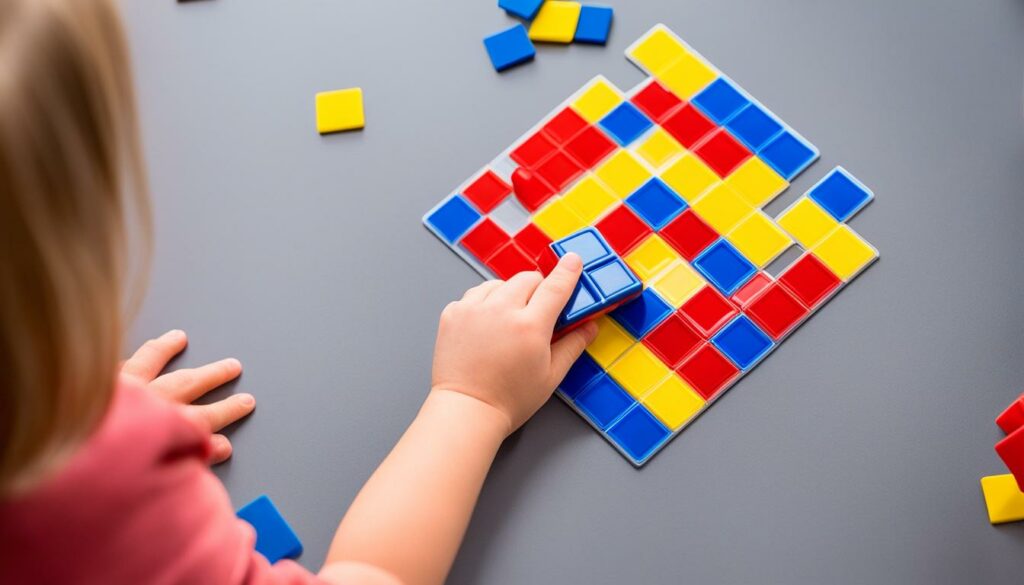
If you’re looking for a toy that sparks creativity and encourages STEM learning, Connetix Magnetic Tiles are the perfect choice. These colorful magnetic tiles allow your child to build and create in endless ways, promoting spatial awareness and problem-solving skills. The strong magnets ensure that their creations stay intact as they explore their imagination and architectural skills. With Connetix Magnetic Tiles, the possibilities are limitless!
Reference:5
PlanToys Wooden Block Set
If you want to enhance your child’s fine motor skills and foster imaginative play, the PlanToys Wooden Block Set is a must-have. This eco-friendly toy features various shapes and sizes of blocks that your child can stack, build, and create with. As they explore the endless building possibilities, they develop hand-eye coordination and problem-solving abilities. Made from sustainably sourced rubberwood, this block set is both durable and safe for your little one.
Reference:5
Haba Marble Run
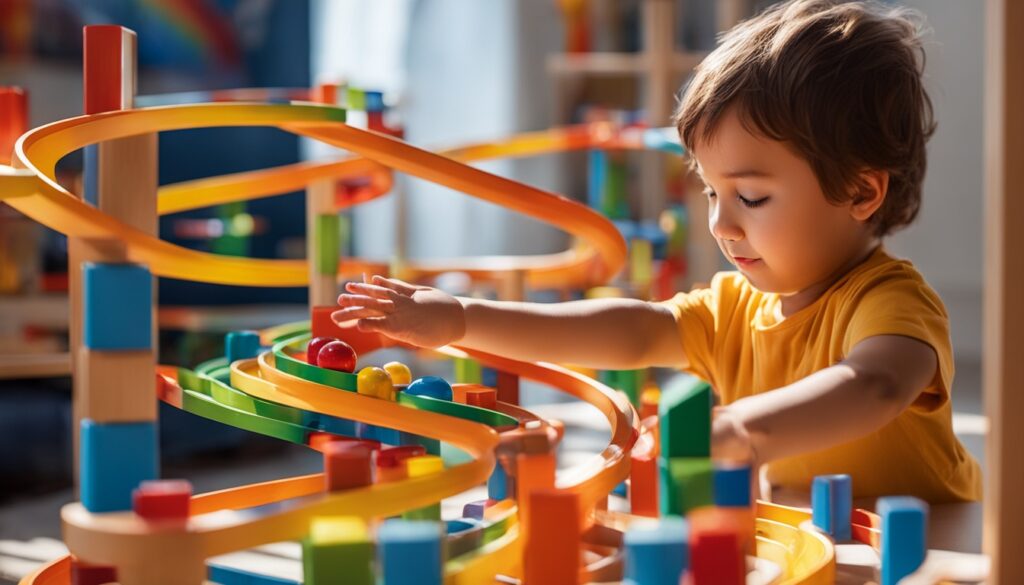
The Haba Marble Run is an excellent toy for fostering critical thinking and experimentation. As your child constructs their own marble run track, they develop logical reasoning skills and learn about cause and effect. They can explore different configurations, test their creations, and observe the marbles’ pathways. This engaging toy encourages problem-solving, patience, and creativity. Let the marble rolling adventure begin!
Reference:5
Tender Leaf Toys Weather Watch Station
If your child is curious about the weather and loves teamwork, the Tender Leaf Toys Weather Watch Station is the perfect educational toy. With this interactive wooden toy, they can observe and learn about weather patterns while role-playing as meteorologists. They can set the dial, slide the thermometer, and record weather conditions on the daily chart. This toy promotes teamwork and communication as children discuss and interpret weather changes. Let them embark on a weather-watching adventure!
Reference:5
Balancing Entertainment and Education
When selecting educational toys for your toddler, it is crucial to strike a balance between entertainment and education. By seamlessly merging learning and play, you can provide your child with a stimulating learning experience while ensuring they have fun and enjoy themselves. After all, the right educational toys have the power to unlock your toddler’s inner genius and contribute to their overall development.
One of the key aspects of educational toys is that they provide entertainment alongside learning. They engage and captivate young minds, making the learning process enjoyable. With the right educational toys, you can create an environment where your child’s inner genius can flourish while they engage in play-based activities.
“Play is often talked about as if it were a relief from serious learning. But for children, play is serious learning. Play is really the work of childhood.” – Fred Rogers
Research has shown that educational toys have immense benefits for a child’s development. They promote cognitive skills, enhance fine motor skills, stimulate creativity, encourage problem-solving, and promote social and emotional growth. By providing an appropriate balance of entertainment and education, these toys engage and inspire children, giving them a strong foundation for learning experiences that transcend the boundaries of traditional teaching methods.
At MindWare, a leading provider of educational toys, you’ll find a wide selection of products specifically designed for four-year-olds6. These include the beloved Plush Craft Pillow Kits, which come in a variety of flavors, shapes, and sizes. The Thames and Kosmos Kid’s First building kits introduce preschoolers to various engineering concepts6. The Design and Drill series offers take-apart vehicles that enable kids to use a motorized mini-drill for assembly6. Other excellent options include the Domino Spill Factory for building fun and the Playful Chef Deluxe Cooking Kit, which enhances literacy and mathematical concepts6.
In addition to MindWare, HABA USA is renowned for its exceptional range of learning toys for toddlers. With a staggering 133 products available, HABA’s emphasis on play as a tool for learning and exploration shines through7. HABA’s toddler toys actively support cognitive skills, fine and gross motor skills, sensory exploration, and social-emotional growth7. These toys introduce fundamental concepts like shapes, colors, and numbers in an interactive way to aid in foundational skill development7. HABA understands the importance of longevity, ensuring their toys are built to last for years of playtime adventures7. Their educational toys also promote the development of fine motor skills, such as hand-eye coordination and dexterity7.
Taking a closer look at HABA’s wide range of toddler toys, play activities like stacking blocks and lacing games significantly promote motor skill development7. With HABA’s toys, children are encouraged to explore their creativity, ignite their imagination, and delve into the realms of learning and discovery7.

| Toy Category | Examples |
|---|---|
| Bikes & Ride on Toys | Balance Bikes, Scooters |
| Building Toys & Sets | Building Blocks, Construction Sets |
| Craft Activities & Kits | Art Supplies, Craft Kits |
| Dolls & Dollhouses | Soft Dolls, Dollhouses |
| Learning Games | Puzzles, Memory Games |
| Outdoor Active Toys & Games | Play Tents, Sports Sets |
| Puzzles | Jigsaw Puzzles, 3D Puzzles |
| Science Toys & Kits | Experiment Kits, Microscopes |
| STEM Toys | Robotics Kits, Coding Games |
Remember, the ultimate goal is to provide your child with a holistic learning experience. By selecting educational toys that strike the right balance between education and entertainment, you can create an environment that fosters your child’s learning, development, and overall growth.
Choosing the Right Educational Toys
When it comes to fostering your toddler’s development, selecting the right educational toys is key. These toys not only provide entertainment but also play a vital role in enhancing cognitive, physical, and social-emotional growth.
As you embark on your search for the perfect educational toys, keep in mind the following factors that contribute to your toddler’s overall learning experience:
- Hands-on Experimentation and Exploration: Look for toys that encourage hands-on engagement, allowing your toddler to explore and discover the world around them. Toys such as puzzles, shape-sorters, and blocks promote problem-solving skills and stimulate critical thinking8.
- Communication and Friendship: Toys that encourage communication and foster friendship are valuable for your toddler’s social development. Consider toys that promote cooperative play and interaction with others, such as pretend play sets, building kits, or musical instruments.
- Multisensory Experiences: Engaging multiple senses is essential for your toddler’s learning journey. Choose toys that offer a variety of textures, colors, sounds, and movements to provide multisensory stimulation.
- Open-ended Play: Opt for toys that allow for open-ended play, where your toddler can use their imagination and creativity without specific instructions or limitations. These toys provide opportunities for self-expression and independent thinking.
- Age-Appropriate Challenges: Consider toys that offer age-appropriate challenges to support your toddler’s growth and development. Toys that adapt and grow with your child allow them to progress at their own pace and continuously learn and discover new skills.
Unlocking Learning Potential
Educational toys serve as powerful tools for unlocking your toddler’s learning potential. They provide a hands-on approach to learning, allowing your child to actively engage with the world around them. Through play, they develop vital cognitive, physical, and social skills that lay the foundation for future learning and success.
By carefully selecting educational toys that align with your toddler’s developmental needs and interests, you can empower them to embark on a lifelong journey of discovery and education.
Remember to be mindful of toy manufacturers’ claims that suggest toys can make children smarter8. While educational toys are indeed beneficial, everyday household items can also serve as effective learning tools for problem-solving and creative play.
Choose educational toys that foster a love for learning and enable your toddler to explore, experiment, and grow. The right toys will not only entertain but also contribute to their overall development and set them on a path of educational success.
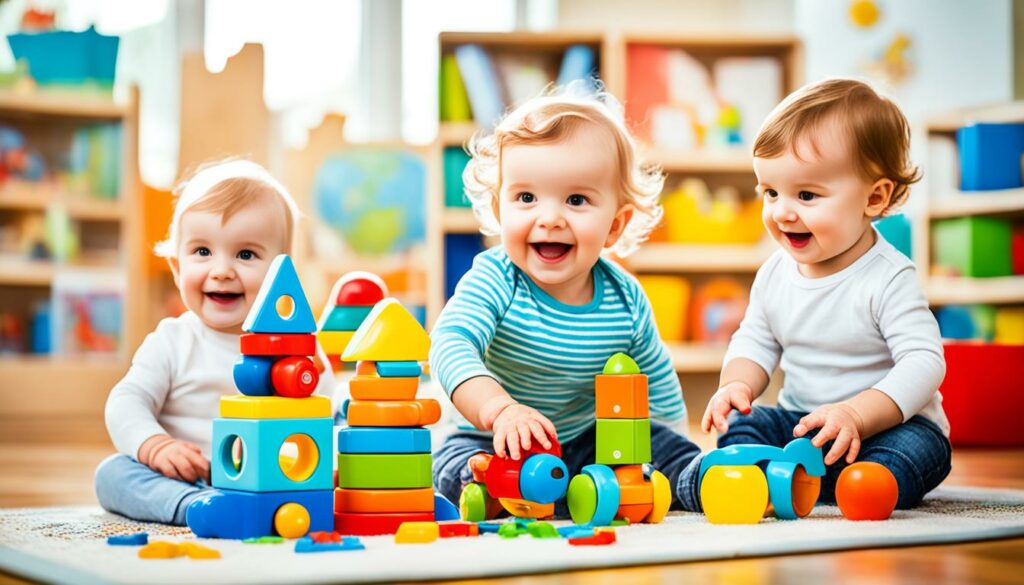
Choosing the Right Educational Toys
| Factors to Consider | Examples |
|---|---|
| Hands-on Experimentation and Exploration | Puzzles, Shape-Sorters, Blocks |
| Communication and Friendship | Pretend Play Sets, Building Kits, Musical Instruments |
| Multisensory Experiences | Toys with different textures, colors, sounds, and movements |
| Open-ended Play | Toys without specific instructions or limitations |
| Age-Appropriate Challenges | Toys that adapt and grow with your child |
Wooden Toys: A Wholesome and Educational Choice
When it comes to choosing toys for your toddler, wooden toys are a fantastic option that offers both calming play experiences and educational benefits. Unlike toys with loud noises or flashing lights, wooden toys provide a serene and soothing environment for your child to explore and learn.
Children learn through play, and wooden toys are designed to offer open-ended possibilities for exploration and creativity. These toys engage your child’s imagination and senses, allowing them to develop their cognitive and physical skills while having fun. Their simplicity and natural textures provide a tactile experience that enhances sensory development.
“Wooden toys are widely recognized for their remarkable durability and are often perceived as being safer for children compared to plastic toys”, according to a study by Madar, A., Boșcor, D., Băltescu, C., & Neacșu9.
Wooden toys are not only safer but are also more environmentally friendly. Being made from a renewable resource, they are considered a more recyclable and sustainable alternative to plastic toys. Choosing wooden toys for your toddler contributes to reducing plastic waste and helps instill eco-friendly values.
Moreover, Montessori-inspired wooden toys are specifically designed to foster problem-solving skills in children. These toys encourage critical thinking, spatial awareness, and logical reasoning, providing your child with the tools they need to approach challenges with confidence.
Open-ended play is crucial for your child’s development, and wooden toys offer the perfect opportunity for it. Unlike toys with a predetermined outcome, wooden toys stimulate your child’s creativity and allow their imagination to run wild. By engaging with these toys, your child can create their own narratives, develop their storytelling skills, and explore various possibilities.
Additionally, having a dedicated toy box to keep your child’s toys organized and easily accessible is highly recommended. A well-organized toy box not only promotes cleanliness and order but also encourages independent play and fosters a sense of responsibility in your child.
Overall, wooden toys are a wholesome and educational choice for your toddler. They provide a calming and serene play experience, foster creativity and imagination, and encourage the development of essential skills. By opting for wooden toys, you are providing your child with a foundation for learning and growth that will benefit them well beyond their toddler years.
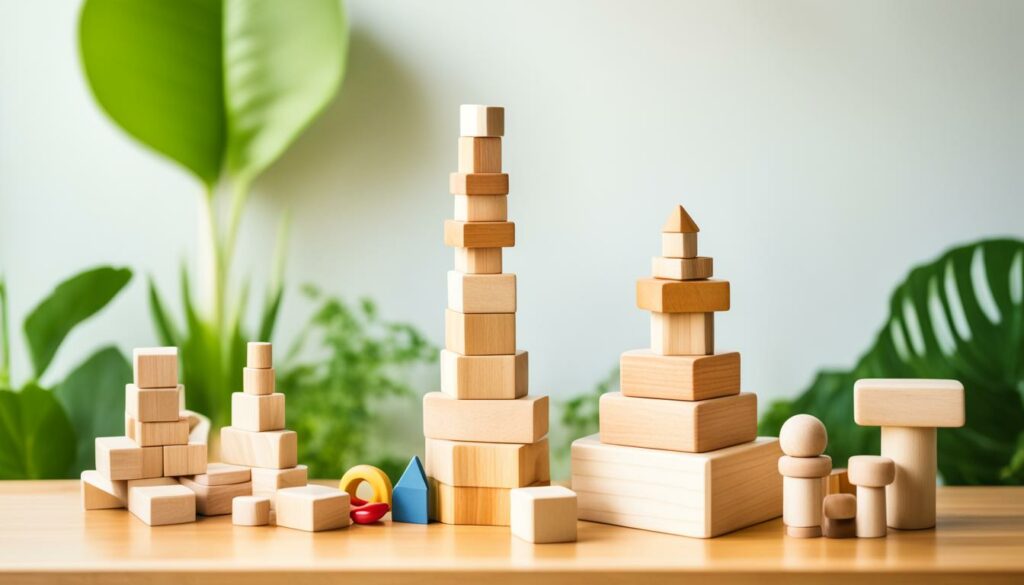
Educational Wooden Toys for Toddlers
When it comes to providing a rich learning experience for your toddler, educational wooden toys are an excellent choice. These toys not only engage and entertain but also support your child’s development in various ways.
One popular option is wooden building blocks, which are perfect for promoting spatial awareness and teamwork. Through building and constructing different structures, toddlers can enhance their problem-solving skills and develop a sense of collaboration with others.10
Shape sorters are another valuable addition to your toddler’s toy collection. These toys help improve hand-eye coordination as children fit different shapes through corresponding holes. Not only do shape sorters sharpen cognitive skills, but they also provide a sense of accomplishment for young learners.11
Wooden figurines of animals are a wonderful way to encourage imaginative play. Acting out stories and creating their own narrative with animal characters stimulates creativity and language development in toddlers. Plus, the tactile experience of holding and manipulating the wooden figurines adds a sensory element to their playtime.11
Stacking toys offer opportunities for order and sequencing. As toddlers stack rings or cups in the correct order, they develop fine motor skills, object permanence, and an understanding of spatial relationships. The satisfaction of successfully building a tower fosters their confidence and sense of achievement.11
Puzzles are fantastic for cultivating cognitive dexterity in toddlers. Solving puzzles requires critical thinking, problem-solving, and spatial reasoning skills. Wooden puzzles with different shapes, colors, and themes provide an engaging and enjoyable learning experience for young children.11
Play kitchens are a must-have for promoting social interaction and imaginative role play. With miniature stoves, sinks, and cooking utensils, toddlers can express their creativity while simulating everyday kitchen scenarios. This type of play nurtures language skills, social development, and an understanding of basic kitchen routines.11
Lastly, wooden train sets can introduce mathematical concepts through movement and representation. As toddlers build train tracks and arrange the train cars, they learn about spatial relationships, cause and effect, and patterns. This hands-on play experience sparks curiosity and lays the foundation for mathematical thinking.11
Summary
Educational wooden toys for toddlers offer a wide range of benefits for their learning and development. From promoting teamwork and spatial awareness with building blocks to enhancing fine motor skills with shape sorters and puzzles, these toys engage young minds in meaningful play experiences. The imaginative play encouraged by figurines and play kitchens nurtures creativity and social skills, while train sets introduce mathematical concepts in a fun and interactive way. Give your toddler the gift of educational wooden toys to inspire their growth and exploration.

| Toy | Price | Discount |
|---|---|---|
| Wooden Building Blocks | $39.97 | 30% |
| Shape Sorters | $44.97 | 22% |
| Wooden Figurines of Animals | $52.97 | 25% |
| Stacking Toys | $59.97 | 17% |
| Puzzles | $84.97 | 35% |
These educational wooden toys provide a perfect balance of entertainment and learning. With their durability and timeless appeal, they can be cherished for years and passed down to younger siblings or future generations. Invest in these educational treasures and watch your toddler’s imagination and skills soar!
The Power of Play and Education
Play and education are powerful partners when it comes to nurturing children’s development and learning. Children naturally engage in play as a way to explore their world, experiment with new ideas, and make sense of their experiences. Educational toys play a crucial role in this process, providing a structured and purposeful way for children to learn through play.
Research has shown that play has numerous benefits for children’s growth and development. It improves their abilities to plan, organize, get along with others, and regulate their emotions12. However, the amount of time children get to play has been declining over the years due to various factors such as tightly structured family and school schedules, limited safe places to play, and increased media use and screen time12. Pediatricians recognize the importance of play in childhood and may even start prescribing play as part of routine well-child visits up to age 212.
“Play keeps us vital and alive. It gives us an enthusiasm for life that is irreplaceable. Without it, life just doesn’t taste good.”
Educational toys offer the perfect blend of entertainment and learning, providing children with valuable educational experiences. They have significant educational value and offer children opportunities to explore, experiment, and learn through playful interactions. These toys can foster cognitive development, enhance problem-solving skills, and stimulate creativity and imagination.
One of the advantages of educational toys is their versatility. Multi-purpose toys, for instance, allow children to use them in various ways, encouraging open-ended play and creativity. By engaging with multi-purpose toys, children can develop essential skills while having fun. This flexibility enhances the power of play and education, making the learning experience more enjoyable and effective.
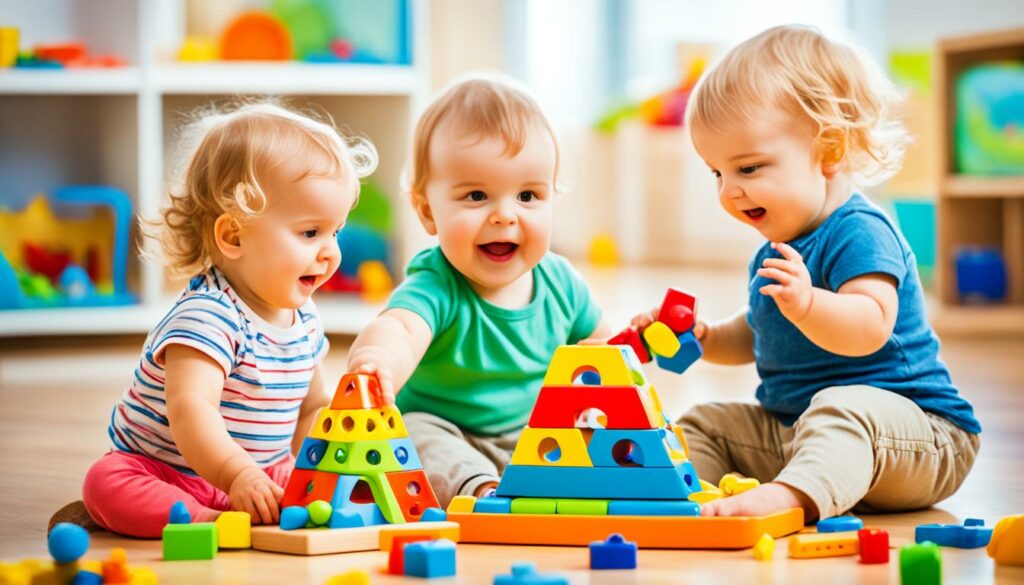
Various studies have highlighted the benefits of play-based learning and the importance of educational toys in supporting children’s educational journey:
| Statistical Data | Key Insights |
|---|---|
| 13,14 | Play-based learning can increase brain activity, creating new neural connections and enhancing future learning capabilities. Educational toys contribute to this learning approach13. Additionally, studies have shown that children play 8 hours fewer games on average per week than two decades ago, highlighting the need for more active play opportunities14. |
| 13 | Educational toys and manipulatives improve spatial awareness and math skills through interactive play, supporting children’s cognitive development13. |
| 13 | Technology integration in early childhood education increases engagement and provides dynamic learning experiences for children13. |
| 13,14 | Nature and outdoor equipment in educational settings promote physical activity and sensory exploration in young learners. Spending time outdoors and engaging in activities with more physical activity are encouraged to combat the trend of decreased active play13,14. |
| 13,14 | Literacy and language resources such as books, puzzles, and storytelling props aid in the development of communication skills and foster a love for reading from an early age13,14. |
Play not only contributes to children’s cognitive development but also helps build safe, stable, and nurturing relationships, which buffer against toxic stress and enhance social-emotional resilience12. Playful interactions with peers, make-believe play, and engaging activities like music, dancing, drawing, storytelling, and imaginative play facilitate socialization and emotional expression, particularly for children aged 1 to 612. Balancing screen time with “real world” activities is recommended for children aged 4 to 6, ensuring a holistic approach to their development12.
By embracing the power of play and education, parents and educators can create an environment where children can learn, explore, and thrive. Educational toys offer endless possibilities for children to develop essential skills, foster creativity, and cultivate a lifelong love of learning.
Embracing Educational Possibilities
When it comes to fostering your child’s learning and development, embracing educational possibilities is essential. By choosing toys that offer open-ended play and learning opportunities, you can create an environment that promotes holistic growth and engagement.
Instead of filling your child’s toy box with objects that limit their range of play, opt for toys that can be used in multiple ways. Open-ended toys, such as building blocks or imaginative play sets, allow children to explore their creativity and problem-solving skills. These toys provide a wide range of play possibilities, stimulating their cognitive development and encouraging hands-on experimentation.
According to studies, educational toys that are age-appropriate and aligned with a child’s developmental stage have shown to be more engaging and effective in promoting learning15.
Open-ended toys encourage learning through play, which is a fundamental aspect of a child’s development. They provide opportunities for children to make choices, think critically, and solve problems. By engaging in open-ended play, children can develop important skills such as creativity, imagination, and sensory-motor coordination.
Reports indicate that toys encouraging open-ended play and hands-on interaction can enhance a child’s creativity, imagination, and sensory-motor skills15.
Educational toys with relevant and engaging educational content also play a significant role in a child’s learning journey. These toys can introduce new concepts, facts, or skills in an interactive and engaging manner, promoting a deeper understanding of the subject matter.
Data shows that educational toys with relevant and engaging educational content can effectively introduce new concepts, facts, or skills to children in an interactive manner15.
When selecting educational toys, safety should always be a top priority. Toys made from non-toxic materials and built to withstand play are essential to prevent accidents or choking hazards.
Safety statistics demonstrate the importance of ensuring that toys are made from non-toxic materials and are durable to withstand play, reducing the risk of accidents or choking hazards15.
Limiting screen time and prioritizing hands-on activities are also crucial for a child’s overall development. By engaging in hands-on play with educational toys, children can enhance their cognitive, physical, and social-emotional skills.
Studies indicate that limiting screen time with educational toys and prioritizing hands-on activities can contribute to a child’s overall development15.
Another important consideration when selecting educational toys is to choose toys that offer varied challenges and opportunities for exploration. Toys that provide different levels of difficulty and encourage curiosity can stimulate a child’s desire to learn and explore.
Research suggests that children benefit more from toys that offer varied challenges and opportunities for exploration rather than those with limited learning potential or single functions15.
Toys that reinforce gender stereotypes can limit a child’s interests and creative expression. Inclusive toys that encourage all children to explore different interests have shown to promote equality and creativity.
Educational experts advise against toys that reinforce gender stereotypes, as inclusive toys that encourage all children to explore different interests have shown to promote equality and creativity15.
It’s important to note that educational toys should promote active engagement and problem-solving skills. Toys that promote passive learning and entertainment without requiring active participation may not be as beneficial for educational purposes.
Data indicates that toys promoting passive learning and entertainment without requiring active engagement or problem-solving skills may not be as beneficial for educational purposes compared to interactive and stimulating toys15.
When selecting educational toys, taking a personalized approach based on your child’s interests and strengths can maximize their learning potential and engagement. Consider their unique preferences and abilities to choose toys that will best support their development.
The personalized approach recommended by experts emphasizes the importance of considering individual children’s interests and strengths when selecting educational toys to maximize their learning potential and engagement15.
By embracing educational possibilities through open-ended toys, relevant educational content, safety, and a personalized approach, you can create an enriching environment for your child’s learning and development.
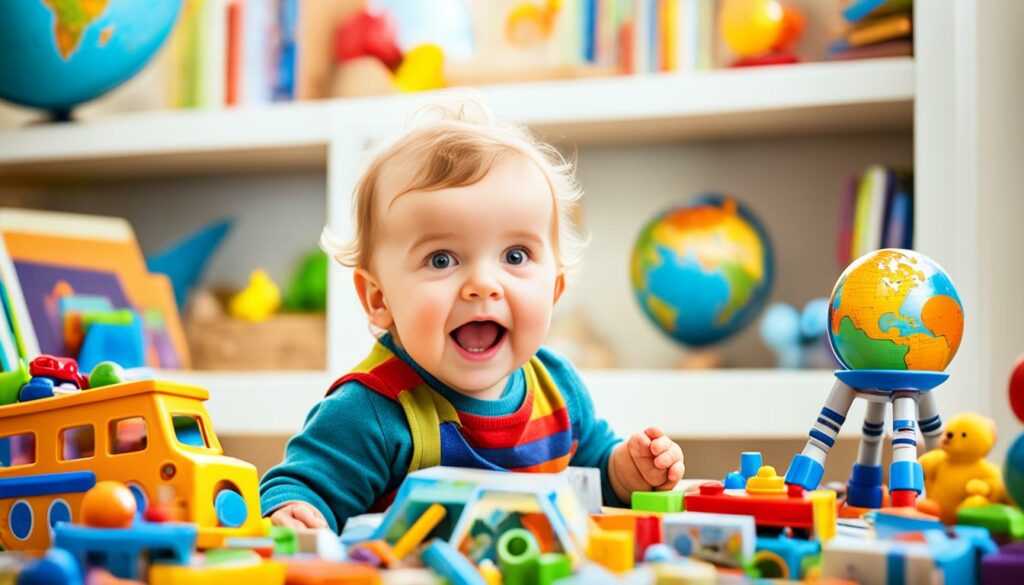
| Benefits of Embracing Educational Possibilities |
|---|
| Encourages holistic growth and engagement |
| Stimulates cognitive development and problem-solving skills |
| Promotes creativity, imagination, and sensory-motor coordination |
| Enhances understanding of new concepts and skills |
| Prioritizes safety and durability |
| Contributes to overall development through hands-on activities |
| Provides varied challenges and opportunities for exploration |
| Promotes equality and creativity by avoiding gender stereotypes |
| Fosters active engagement and problem-solving skills |
| Maximizes learning potential and engagement through personalization |
Unlocking Your Toddler’s Inner Genius
Educational toys are key to unlocking your toddler’s inner genius. By providing them with the right toys, you can enhance their learning and development. These toys play a crucial role in cognitive development, promoting critical thinking skills, and sparking curiosity.
When choosing educational toys, it’s important to consider the specific needs and interests of your child. Each toy has its own unique features and benefits. For example, Montessori educational toys are known for their focus on hands-on learning and self-directed exploration1617. These toys foster a sense of independence and encourage children to think creatively and solve problems.
Bilingual educational toys, such as interactive language flashcards, are ideal for language development16. These toys expose toddlers to different languages, helping them develop strong communication skills.
Sensory toys that incorporate voice recognition provide a multi-sensory learning experience16. These toys stimulate different senses, enhancing a toddler’s cognitive development while engaging them in play.
Arithmetic toys are great tools for developing mathematical skills in young children16. Through activities like counting, sorting, and recognizing shapes, toddlers can build a strong foundation in numeracy.
Wooden toys are popular choices due to their durability and tactile nature16. These toys encourage fine motor skill development and offer a sensory experience with their natural textures.
Logic and problem-solving toys, such as puzzles and building sets, challenge toddlers to think critically and find solutions16. These toys promote cognitive development and enhance problem-solving skills.
By selecting educational toys that align with your toddler’s interests and stage of development, you are providing them with the tools they need to unlock their inner genius. These toys create a foundation for future learning and set the stage for lifelong curiosity and growth.
The Endless Possibilities of Educational Toys
Educational toys offer endless possibilities for learning and play. They provide young minds with engaging experiences that promote growth, development, and a love for learning. Among the diverse selection of educational toys, wooden classics stand out as timeless options that continue to captivate children’s imaginations.
Wooden classics are beloved for their durability, natural beauty, and ability to inspire learning through play. Whether it’s a set of colorful building blocks, a shape-sorting puzzle, or a pretend play kitchen, wooden toys are designed to nurture various skill sets while fostering creativity and exploration.
These learning tools are perfectly pitched to help children develop essential skills while having fun. From problem-solving to fine motor skills, cognitive development, and language acquisition, wooden classics cater to a wide range of developmental needs.
One of the key advantages of educational toys is their ability to provide a lasting learning experience for children. As they play with wooden classics, children engage in hands-on activities that promote critical thinking, concentration, and coordination. They discover cause and effect, develop spatial awareness, and learn to communicate and interact with others.
According to18, educational toys for infants and toddlers provide benefits in language acquisition, cognitive development, and motor skills.
Research shows that young children tend to focus more on visual learning activities, making educational toys an excellent choice for their developmental needs. Through engaging visuals and interactive play, these toys create a stimulating environment that supports learning and discovery.
According to18, young children tend to focus more on visual learning activities.
Another advantage of educational toys is that they are designed to cater to different age ranges. From infants as young as 1 year old to teenagers up to 18 years old, educational toys provide age-appropriate challenges and learning opportunities that adapt to a child’s developmental stage.
As18 suggests, age recommendations for educational toys range from 1 year to 18 years old.
It’s important to note that children have different learning styles. Visual, auditory, and kinesthetic learning styles play a significant role in how children understand and process information. Educational toys, including wooden classics, often incorporate multiple sensory experiences to cater to these varying learning styles.
According to18, visual, auditory, and kinesthetic are the three main types of learning styles.
When it comes to choosing educational toys, parents and caregivers have a plethora of options available. Brands like HABA USA offer a wide range of toddler learning toys that support growth and development in various areas.
According to statistics from7, HABA USA provides 133 products specifically designed for toddlers.
Toddler toys from HABA USA emphasize cognitive skills, fine and gross motor skills, sensory exploration, and social-emotional growth. These toys are thoughtfully designed to introduce important concepts such as shapes, colors, and numbers in a fun and interactive way.
As7 suggests, HABA USA toddler toys emphasize cognitive skills, fine and gross motor skills, sensory exploration, and social-emotional growth.
Through play-based activities, HABA USA’s educational toys promote cognitive development, creativity, imagination, and problem-solving abilities. Stacking blocks, fitting shapes, and engaging in imaginative play are just a few examples of the activities that can enhance fine motor skills, hand-eye coordination, and precision in young children.
Based on7, activities with HABA USA toddler toys can enhance fine motor skills, hand-eye coordination, and precision in young children.
With their emphasis on educational value and adherence to safety standards, HABA USA’s wide range of fun and educational toddler toys are designed to inspire learning and creativity.
7 states that HABA USA offers a wide range of fun and educational toddler toys designed to inspire learning and creativity.
As we explore the endless possibilities of educational toys, it’s important to consider the holistic development of young children. Toys that engage various senses, promote critical thinking, and encourage open-ended play contribute to a well-rounded learning experience.
Educational toys, especially wooden classics, make it possible for children to learn, grow, and have fun simultaneously. They provide young minds with the opportunity to explore their surroundings, develop important skills, and create lasting memories.
So, embrace the endless possibilities of educational toys and watch as your child unlocks their full potential through the power of play.
Conclusion
Educational toys are essential for a toddler’s growth and development. They play a vital role in stimulating cognitive development, enhancing problem-solving and critical thinking skills19. Toys that require verbal interaction, such as talking dolls and toy telephones, help improve vocabulary and language skills19. Fine motor skills activities, like building with blocks and playing with manipulative toys, improve hand-eye coordination and dexterity19. Gross motor skills activities, including playing with balls and outdoor playsets, promote coordination, balance, and physical strength19.
Educational toys also foster social skills, such as turn-taking, cooperation, and problem-solving, through board games19. They encourage creativity and imagination, fostering problem-solving and critical thinking skills19. By choosing educational toys that capture a child’s interests, parents can enhance learning experiences and benefit their development19.
Introduction to educational toys in early childhood impacts cognitive, emotional, and social development20. From alphabet-focused toys to mathematical educational toys, they contribute to language development, fine motor skills, problem-solving abilities, and cognitive development20. Science-based educational toys foster curiosity, scientific thinking, and critical skills20. Building blocks aid in developing fine motor skills, spatial awareness, and creativity20. Storytelling toys enhance verbal communication skills and encourage imaginative play20. Musical instruments contribute to cognitive abilities, rhythm recognition, and auditory discrimination20. Fine motor skill toys improve hand-eye coordination and finger strength20. Role-playing toys help develop social skills, empathy, and problem-solving abilities20. Eco-friendly toys teach children about environmental responsibility and inspire creativity20.
Although educational toys can come at a cost, ranging from $25 to $50 for a good quality product21, they are widely advertised as beneficial tools for children’s learning and development21. Reputable brands offer engaging and effective educational toys that enhance a child’s development21. Online platforms provide a wide range of options, allowing parents to choose from a variety of educational toys21. It is important to note that not all toys are equally effective, and choosing toys tailored to a child’s age and learning style can enhance their learning experience21.
FAQ
Why are educational toys important for toddlers?
What are the benefits of educational toys?
What are some of the top educational toy picks?
How do educational toys balance entertainment and education?
How can I choose the right educational toys for my toddler?
Why are wooden toys a good choice for toddlers?
What are some educational wooden toys for toddlers?
How does play and education go hand in hand?
How can I embrace educational possibilities with toys?
How can educational toys unlock my toddler’s inner genius?
What are the endless possibilities of educational toys?
How do educational toys contribute to a toddler’s learning and development?
Source Links
- https://playroomavenue.com/blogs/blog/unlock-learning-adventures-with-educational-toys
- https://childdevelopmentinfo.com/learning/multiple_intelligences/educational-benefits-toys/
- https://www.fiestacrafts.co.uk/blog/article.php?DOC_INST=2
- https://www.safesearchkids.com/the-benefits-of-learning-toys-designed-for-child-development/
- https://montessorigeneration.com/collections/montessori-toys-for-2-year-olds
- https://www.mindware.orientaltrading.com/4-years-old-a1-90000 2315-1.fltr
- https://www.habausa.com/collections/developmental-toys-toddler
- https://www.zerotothree.org/resource/tips-for-choosing-toys-for-toddlers/
- https://www.bumbutoys.com/blog/wooden-toys/wooden-toys-vs-plastic-toys
- https://faoschwarz.com/collections/wood-toys-toddler
- https://habausa.com/collections/developmental-toys-toddler
- https://www.healthychildren.org/English/family-life/power-of-play/Pages/the-power-of-play-how-fun-and-games-help-children-thrive.aspx
- https://www.childrensfactory.com/blog/2024/05/17/unleashing-the-power-of-play-transforming-early-education/
- https://www.ncbi.nlm.nih.gov/pmc/articles/PMC8430366/
- https://edxeducation.com/what-features-in-educational-toys-should-you-look-for-or-even-avoid/
- https://medium.com/@william.haugland/unlock-your-toddlers-inner-genius-10-educational-toys-that-transform-learning-into-play-time-e0d4a2ee123d
- https://lurnsmart.com/babygenius/
- https://www.linkedin.com/pulse/what-benefits-educational-toys-infants-toddlers-rebecca-sylvain
- https://williamthewriter.medium.com/the-benefits-of-educational-toys-for-child-development-69f4e2e851ea
- https://www.fundemoniumtoys.com/building-bright-minds-the-power-of-educational-toys-for-early-childhood-development/
- https://www.linkedin.com/pulse/what-impact-educational-toys-childs-development-rebecca-sylvain

